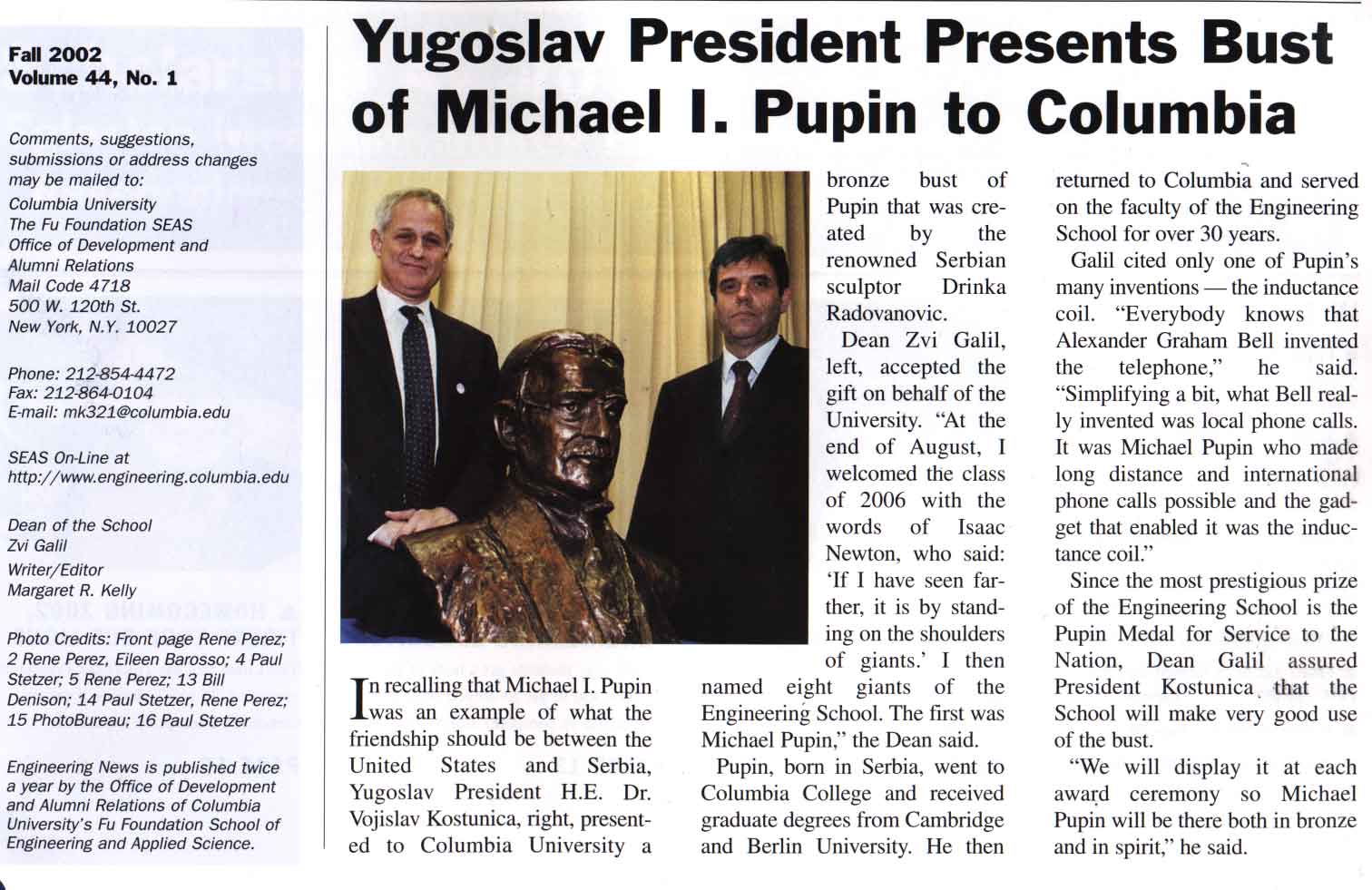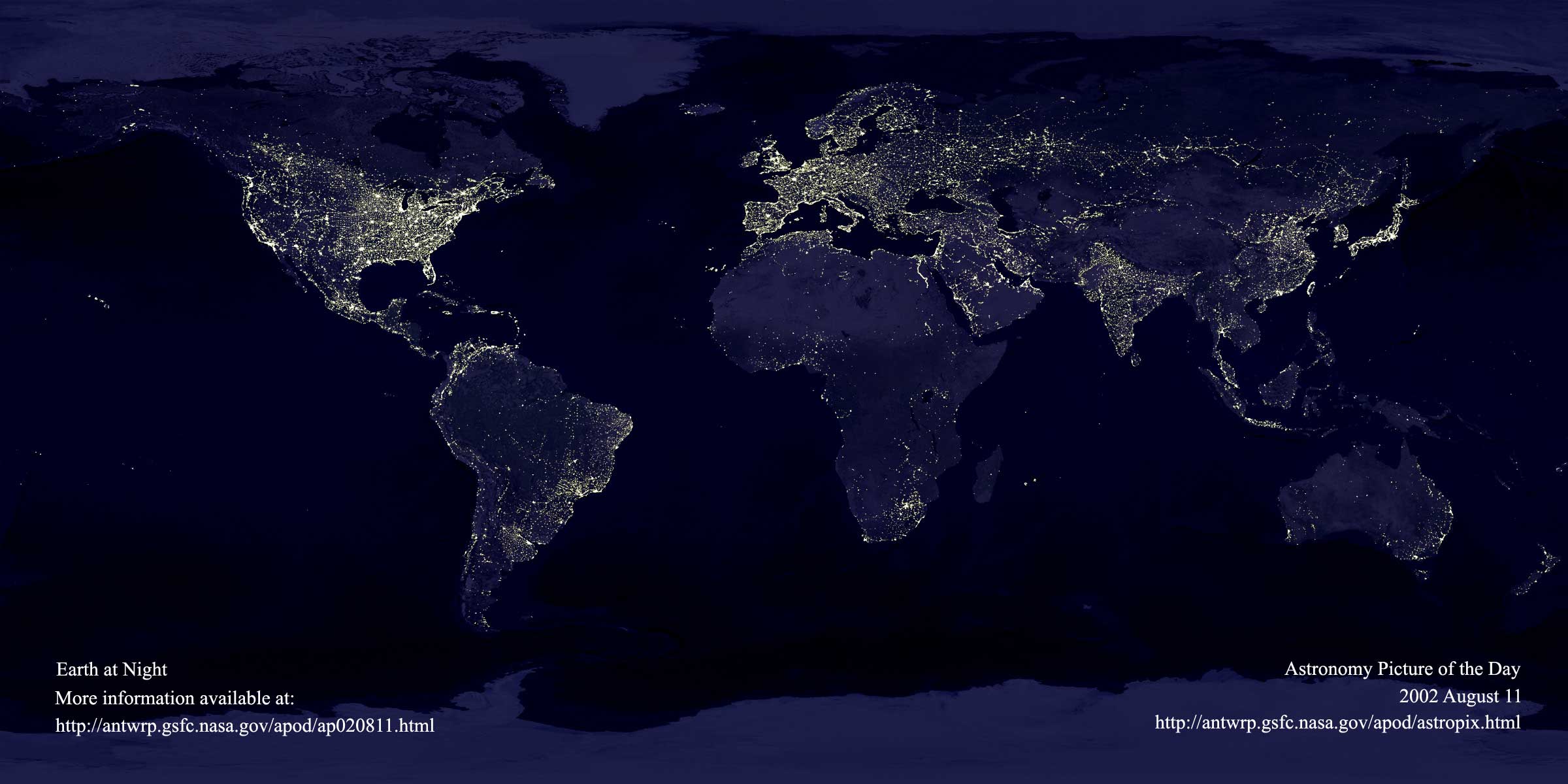
Welcome to the Tesla Memorial Society of New York Website
Visit of Serbian Academy of Sciences and Arts to New York City on June 15 -17, 2005

Above: New York City, Manhattan.
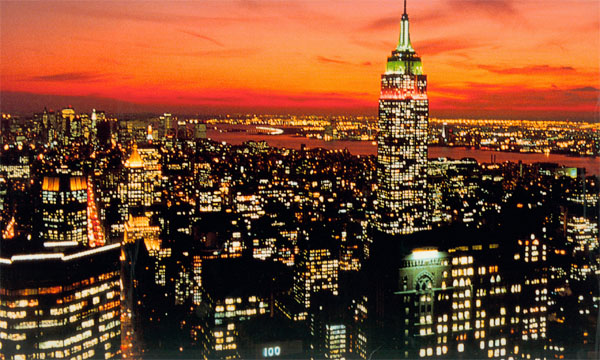
Above: Night view of Manhattan from Tesla's window on the 33rd floor, Hotel New Yorker.
High ranking delegation of the Serbian Academy of Sciences and Arts will visit New York City in commemoration of the 150th Anniversary of the birth of Michael Pupin, a distinguished Serbian-American scientist and inventor and long time professor of Columbia University, previous President of New York Academy of Sciences and member of the Academy of Sciences in Washington D.C. Michael Pupin was a founder of Astronautical Department of National Academy of Sciences, which is a precursor of today's NASA.
The high ranking Serbian Academy of Sciences officers that will be visiting:
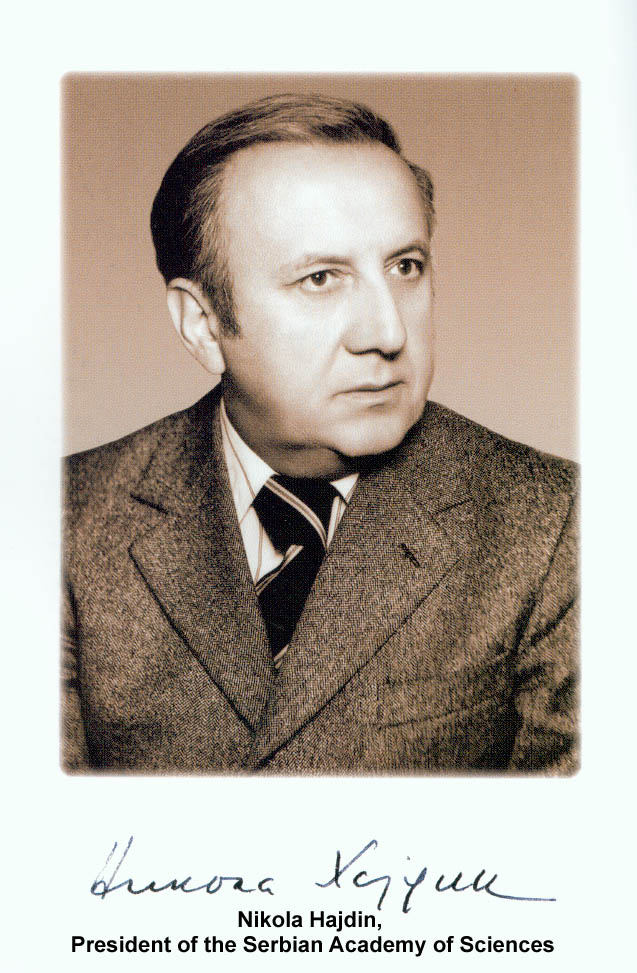

Above: This Glaznja arch dam near Kumanovo was designed by Nikola Hajdin.
-
Academician Nikola Hajdin, President of the Serbian Academy of Sciences, a world authority on designing and building bridges. He is a university professor, writer and educator. His solution for the design of modern bridges are beautiful, practical and ingenious. He designed an international bridge by the city of Novi Sad over the Danube River. Now in construction - an international bridge in Poland.
-
Academician Professor Aleksander Marincic - professor of telecommunication in Belgrade University, previous director of the Nikola Tesla Museum in Belgrade and a writer, educator and organizer of many international symposiums on Nikola Tesla and Michael Pupin.
-
Martin Selak - Chicago Businessman, engineer and inventor. The founder of the Society of Inventors in Serbia and Montenegro. Mr. Selak is an organizer of the Serbian Academy of Sciences visit to the United States.
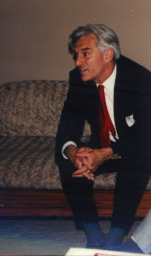
Above: Prof. Dr. Aleksandar Marincic, previous director Nikola Tesla Museum, Belgrade.

Above: Martin Selak (bottom left picture) is the founder of the Society of Inventors in Serbia and Montenegro.
During the visit in New York City, the delegation of Serbian Academy of Sciences will visit Columbia University, New York Academy of Sciences and will have a meeting with representatives of the IEEE, regarding the reestablishment of the "Nikola Tesla Award" (Serbian part of the Award). The Nikola Tesla Award, is being given yearly since 1976 by the IEEE. This is an international award given to prominent scientists and inventors around the world.
An Evening at Columbia University,
New York
Thursday, June 16th, 2005
6:30 - 8:30pm Graduate Student Lounge, Philosophy Hall
Columbia University, New York
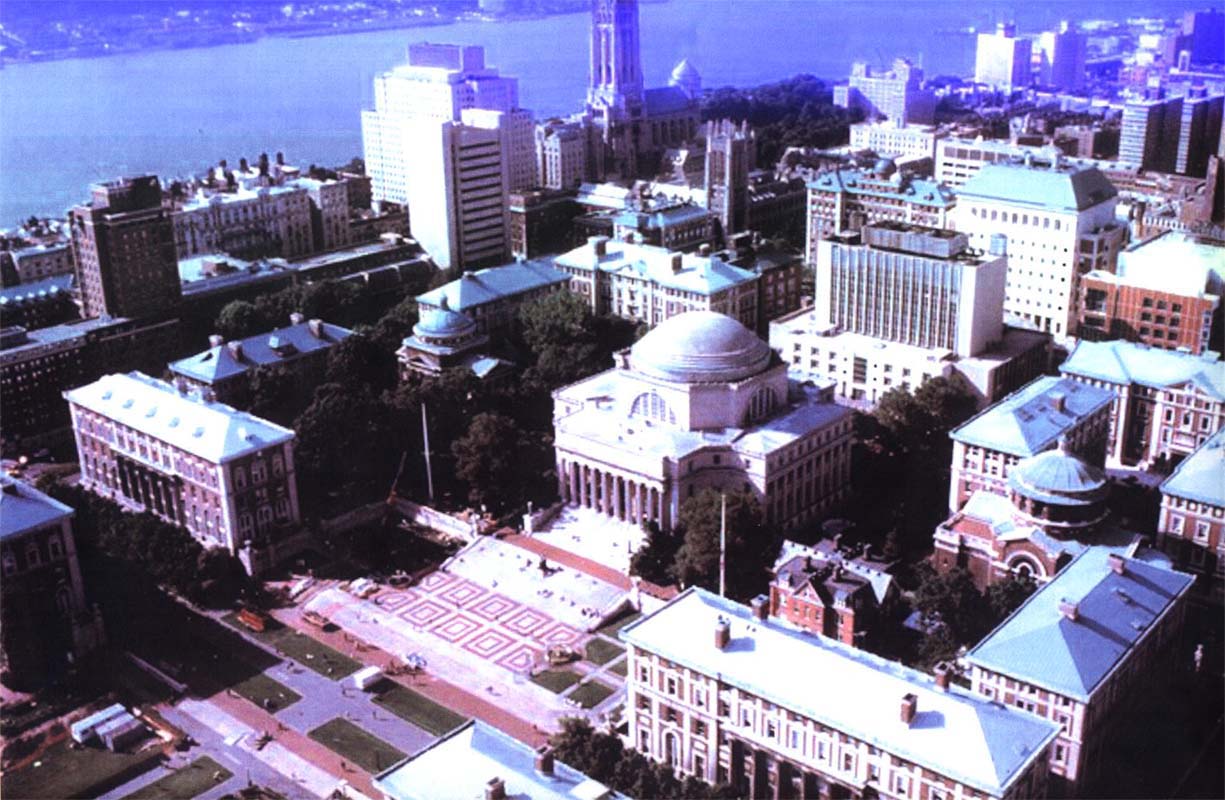
Above: Columbia University, New York.
Above: Columbia University, New York.
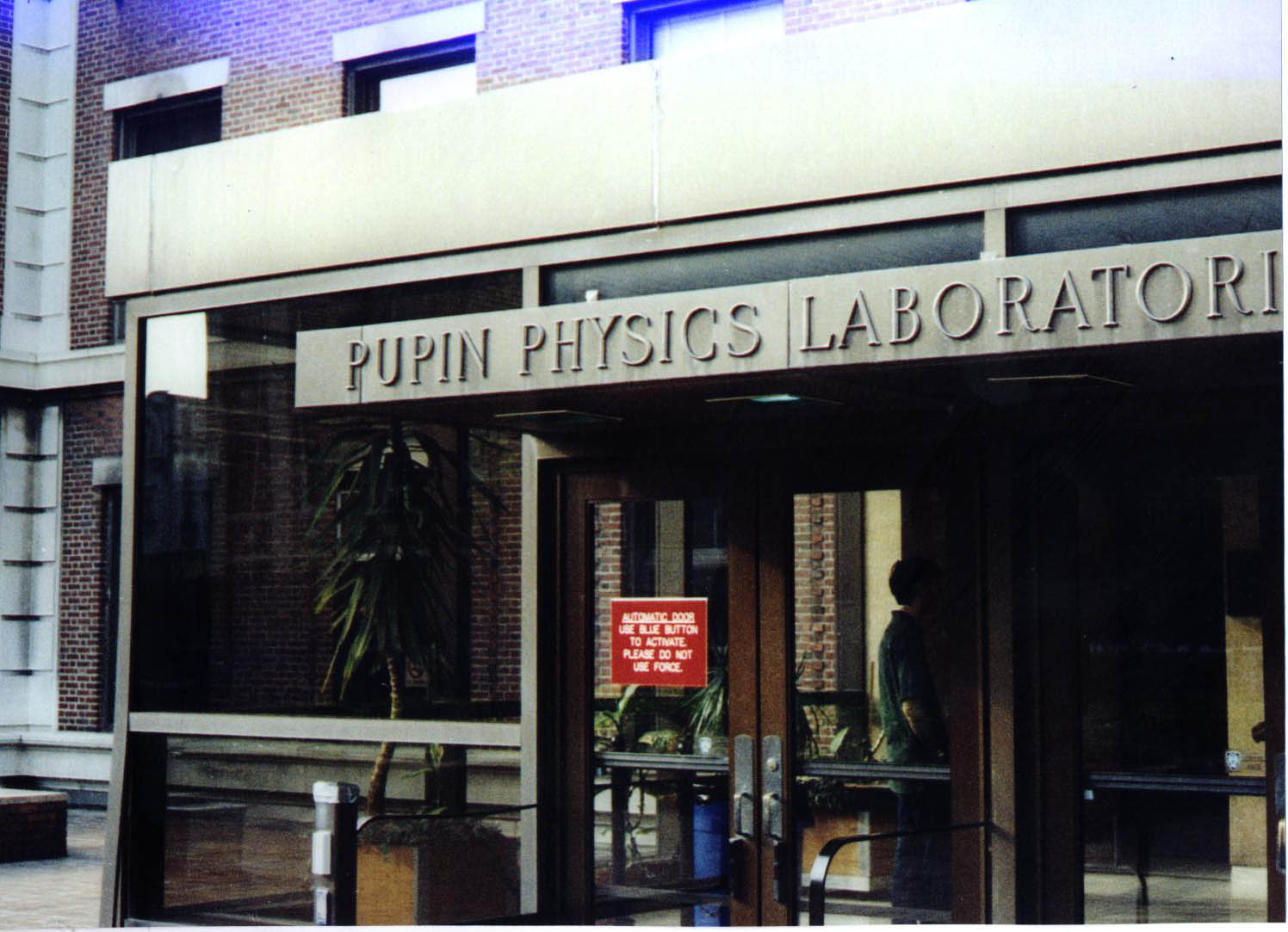
Above: Entrance to Pupin Physics Laboratories, Columbia University, New York.
Above: Pupin Physics Laboratories, Columbia University, New York.
This famous building was given the name "Pupin Physics Laboratories" after Pupin's death in 1935. There are 29 Noble Prize winners who did their scientific work at this famous building. Significant scientific discoveries in the 20th century took place in this building. The "Manhattan Project" which produced the first Atomic Bomb started with scientific research conducted in Pupin Physics Laboratories.
Columbia University has 61 Noble Prize winners which is unsurpassed in the history of science and research. American President Eisenhower was also the President of Columbia University.
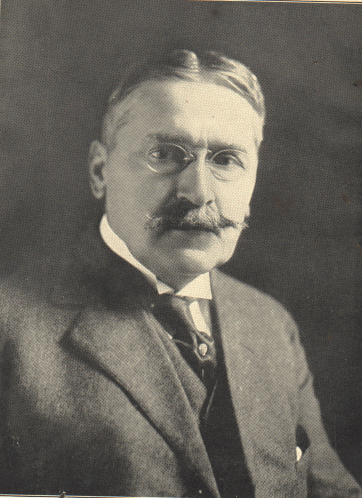
Above: Michael Idvorsky Pupin (1854 -1935)
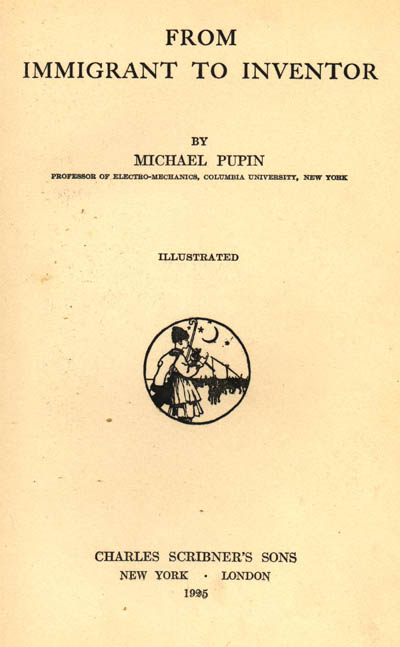
Above: This is the famous autobiography of Michael Pupin "From Immigrant to Inventor" which received the Pulitzer Prize in 1924.

Above: The Pulitzer Prize Awarded to Michael Pupin, 1924, for his autobiography "From Immigrant to Inventor"
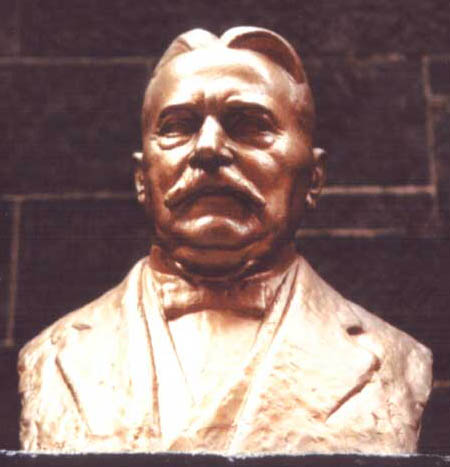
Above: Michael Idvorsky Pupin Bust, work of Ivan Mestrovic, world famous sculptor and friend of Michael Pupin and Nikola Tesla. This bust was unveiled in Pupin Hall, Columbia University, New York City on May 21, 2004.
Above: Masters of the ceremony of unveiling of Michael Pupin bust at Columbia University, Pupin Hall - Lalla R. Grimes, Administrative Coordinator Columbia Physics Department and Dr. Ljubo Vujovic, General Secretary Tesla Memorial Society of New York

Above: Pupin Coil at the Smithsonian Museum, Washington D.C.
In commemoration of the 150th Anniversary of the birth of Michael Pupin.
The evening is organized by the Njegos Endowment for Serbian Language and Culture at Columbia University together with the Harriman Institute and the East Central European Center.
Program:
-
6:30 pm: Welcome and Introduction, Catharine Theimer Nepomnyashchy, Director, Harriman Institute
Lectures:
-
Professor Aleksander Marincic: "Michael Pupin: Life and Legacy"
-
Professor Nikola Hajdin: "Modern Bridges in Serbian"
The speeches will be followed by the presentations of medals from the Serbian Academy of Sciences and Arts to members of the Columbia University Physics Department and the New York Tesla Memorial Society.
Awardees:
-
Prof. Zvi Galil, Dean of the Engineering School at Columbia University.
-
Lalla R. Grimes, Administrative Coordinator, Physics Department, Columbia University.
-
Dr. Ljubo Vujovic, Secretary General, Tesla Memorial Society of New York
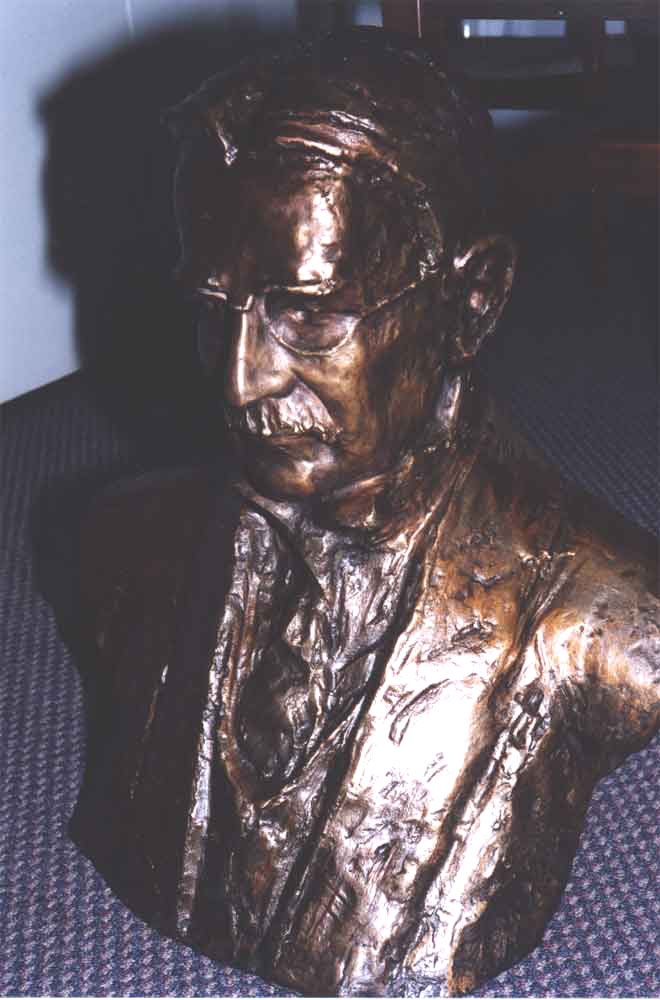
Above: The Michael Pupin Bust created by renowned Serbian Sculptor Drinka Radovanovic. This bust was a personal gift from Yugoslav President Dr. Vojislav Kostunica to Columbia University, New York.
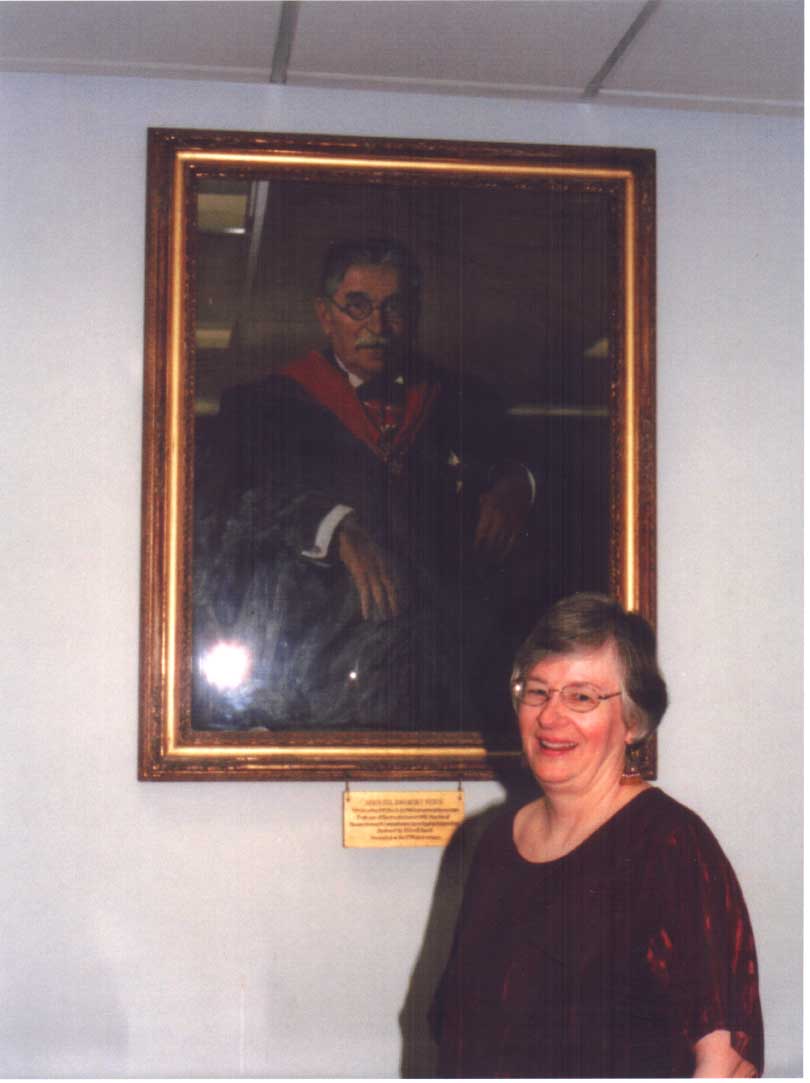
Above: Lalla Grimes - Administrative Coordinator, Pupin Physics Laboratories, Columbia University below the painting of Michael Pupin at the Pupin Physics Laboratories, Columbia University, New York. Without her vision, idealism, persistence and hard work the unveiling of the Pupin bust would not be possible. We thank her for that.
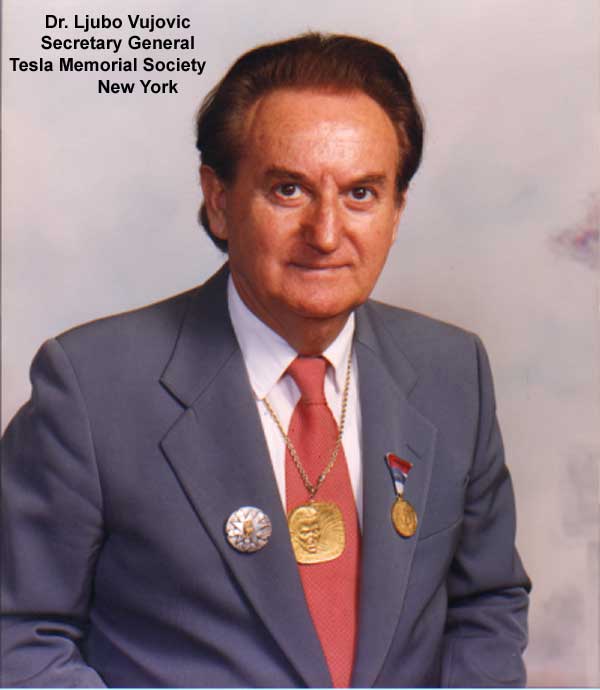
Dr. Ljubo Vujovic, Secretary General, Tesla Memorial Society of New York.
Visit to New York Academy of Sciences
The Delegation of the Serbian Academy of Sciences and Arts will visit the New York Academy of Sciences where Serbian American Inventor and Scientist Michael Pupin was the President of the New York Academy of Sciences and Nikola Tesla, a Serbian-American scientist and inventor, was a member and had several famous lectures held at the Academy.
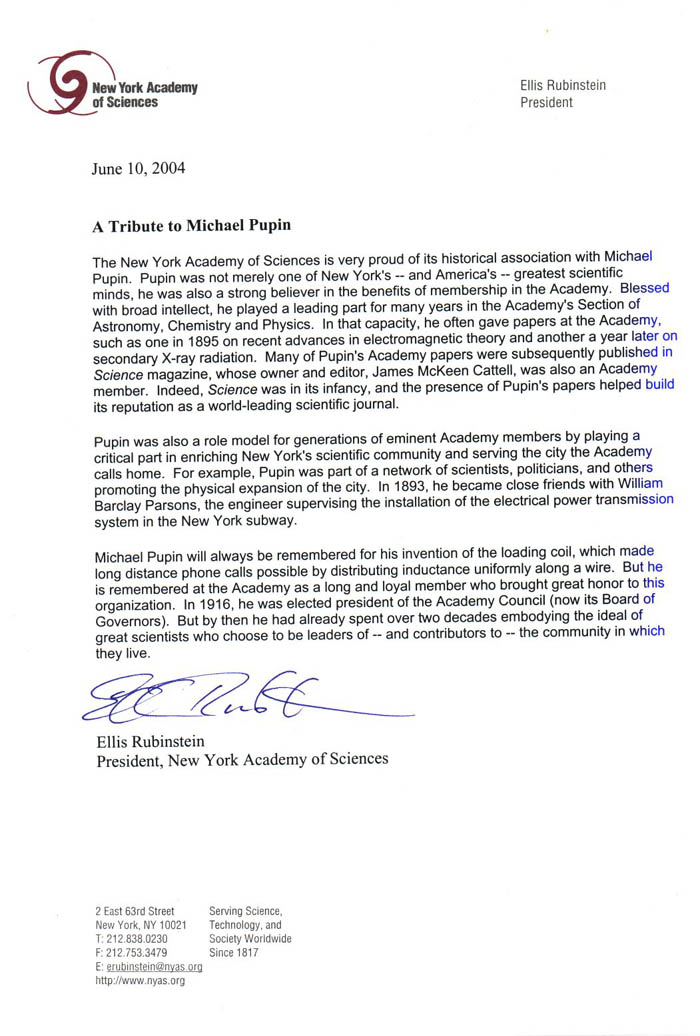
Above: The President of the New York Academy of Sciences wrote "A Tribute to Michael Pupin" celebrating 150 years of Pupin's birth.
Meeting with the Representative of the IEEE
The Delegation of the Serbian Academy of Sciences and Arts will meet with the representatives of the IEEE regarding the reestablishment of the "Nikola Tesla Award", the Serbian part of the award (the other part was given by the IEEE).
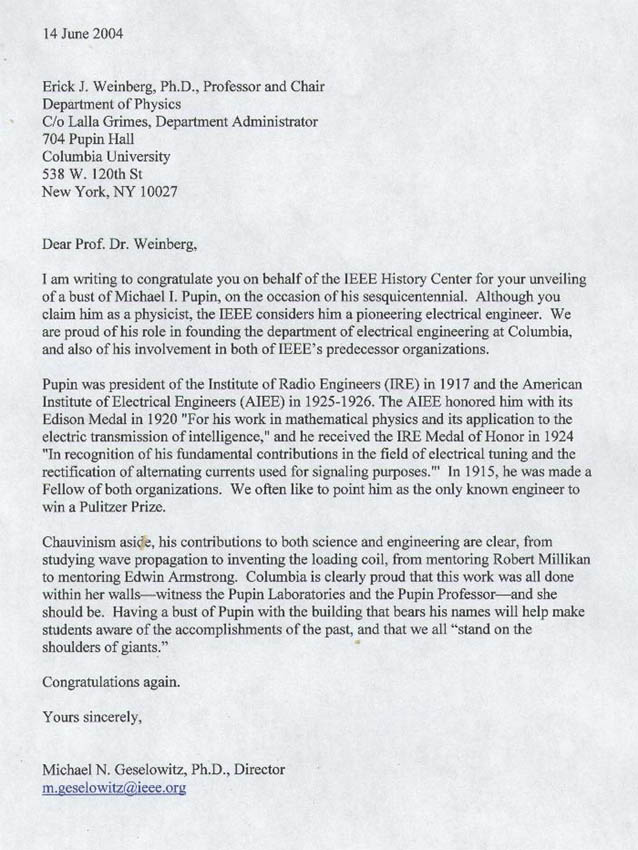
Above: Tribute to Michael Pupin from the History Center of the Institute of Electrical Electronic Engineers.
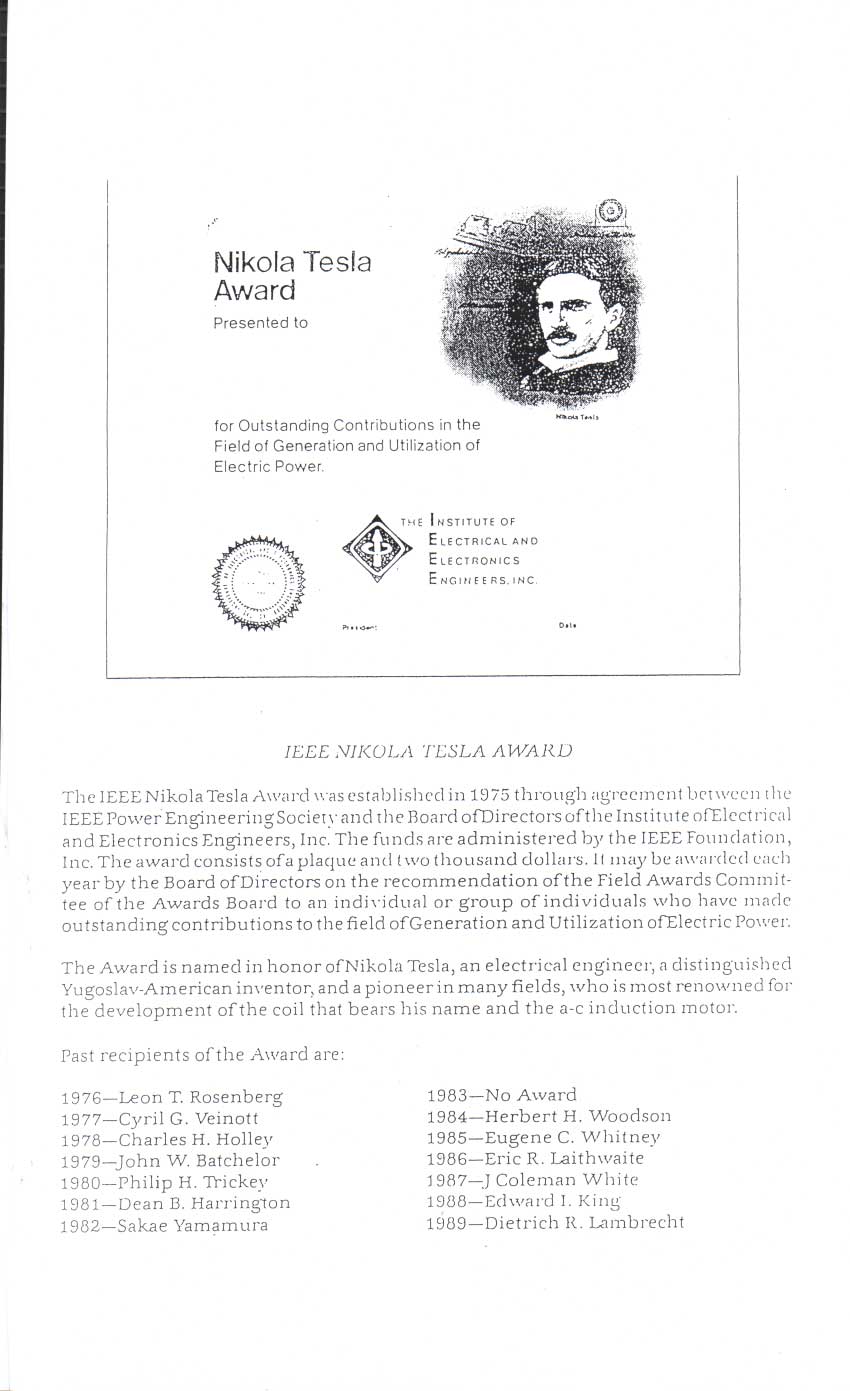
The "Nikola Tesla Award" is being given yearly by the IEEE since 1976, an international award given to scientists and inventors around the world for the accomplishments in electrical engineering.
The great Serbian-American scientist and inventor, Nikola Tesla, was placed among the "100 Greatest Americans" by the Discovery Channel in June 2005.
Nikola Tesla, was placed among the "100 Greatest Americans"
Nikola Tesla was placed by Time Magazine, among the 100 Greatest Men in History.
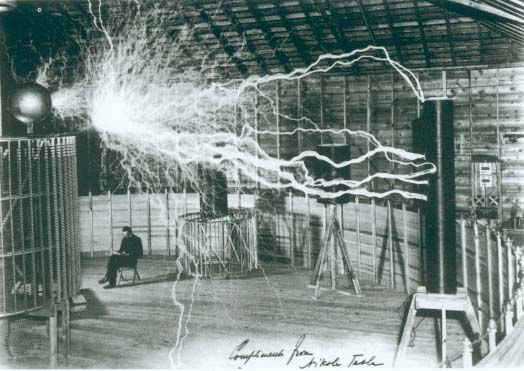
Above: Tesla sits below the Tesla Coil in his Colorado Spring Laboratory. The coil creates millions of volts of electricity with a frequency rate of 100,000 alterations per second.
Above: Earth at Night, Click to Enlarge.
This is a satellite photo at night depicting Tesla's alternating current
electricity all over the world. This electricity is run by Tesla's
Alternating Current which is lighting the whole world.
Nikola Tesla is "the genius who lit the world". His alternating
current motor is the main power supplier of the whole world,
transferring electrical energy into mechanical energy and vise versa.
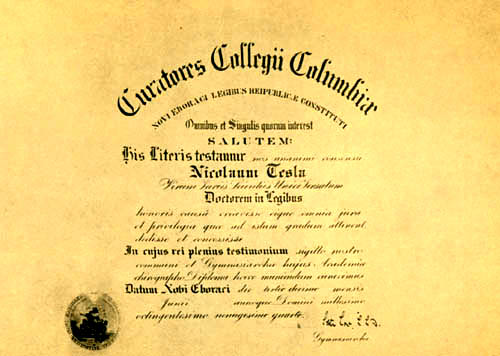
Above: Tesla Diploma of honorary Doctor of Collegium Columbiae (June 1894)
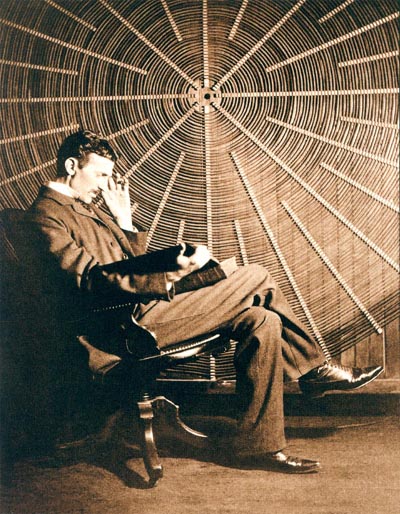
Above: Nikola Tesla, with Roger Boskovich's book "Theoria Philosophiae Naturalis", in front of the spiral coil of his high-frequency transformer at East Houston St., New York
Tesla’s Connection to Columbia University
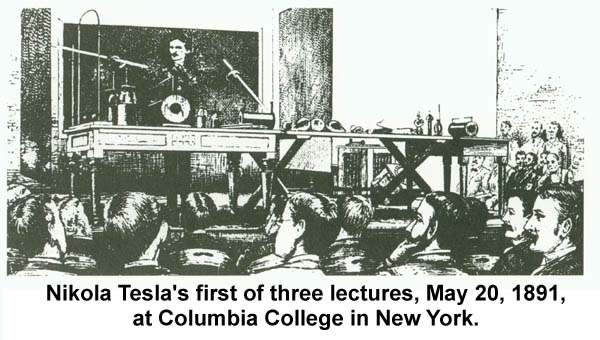
Introduction by Tesla Memorial Society of New York:
Distinguished American scientist, writer, educator, Dr. James R. Corum, an expert on Tesla's work and life, wrote this article for our website, www.teslasociety.com to shed some light on Tesla's activities in Columbia University. Tesla had several lectures at Columbia University on 1888, 1891,1893. With those lectures he announced a new era in the utilization of alternating current electricity and induction motor, and also, the high frequency, high voltage electricity. Both types of electricity are used today to make our lives better and to provide communication between nations and continents. With his lectures at Columbia University, Tesla changed the electrical engineering department in Columbia University and made the 20th century possible with its progress in electricity and communication. The 20th century is the electro-magnetic century. With his lectures he gave Columbia University prominences over other institutions in the world. The Tesla Memorial Society of New York is grateful to Dr. James Corum for this important article.
-Dr. Ljubo Vujovic, Secretary General, Tesla Memorial Society of New York
Tesla’s Connection to Columbia University
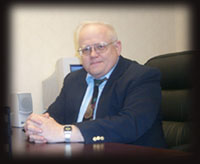
by
Dr. James F. Corum, Ph.D., June 12, 2005.
“The invention of the wheel was perhaps rather obvious; but the invention of an invisible wheel, made of nothing but a magnetic field, was far from obvious, and that is what we owe to Nikola Tesla.” Professor Reginald Kapp, 1956
INTRODUCTION
The Electrical Engineering curriculum at Columbia University, though not the first in the US, is one of the oldest and most respected programs in the world. From the beginning, a conscientious effort was made to base it on a foundation of science. It has been guided by the philosophy stated by Professor Michael Pupin, “Professor Crocker and I maintained that there is an ‘electrical science’ which is the real soul of electrical engineering.”
Arguably the most stunning and significant lecture in modern history was presented one spring evening more than a century ago at Columbia University. The wealth of nations turned on its outcome. Weighing on the balances would be our vast cities, civilization, and quality of life. It was Tesla’s great discovery of the rotating magnetic field and a means for the electrical distribution of energy.
Charles F. Scott, past President of the AIEE has said, “The evolution of electric power from the discovery of Faraday to the initial great installation of the Tesla polyphase system in 1896 is undoubtedly the most tremendous event in all engineering history.”
Assembled in that Columbia lecture hall were not only members of the academic world, with representatives from Columbia, Cornell, MIT, Yale and Johns Hopkins, but also the giants of industry from Westinghouse, Edison and General Electric, and also delegates from various trade journals, which soon spread the news of this great discovery.
In the same Columbia University atmosphere, three years later, in 1891, Tesla would present his discoveries in the realm of high frequency engineering and demonstrate the principle of coupled tuning. He would announce and demonstrate a technology that would raise the average power developed by RF sources five orders of magnitude! Such a remarkable innovative feat has never been repeated.
[There was also a third New York Lecture, though not presented at Columbia. It was delivered on April 6, 1897 at the New York Academy of Sciences, and it concerned high power RF apparatus, x-ray production, and new frequency measurement techniques.]
SPECIFIC LINKS BETWEEN TESLA AND COLUMBIA UNIVERSITY
There are at least three links to Tesla from Columbia University.
1. Conferral of an Honorary LL.D. by Columbia.
It was Professor Henry Fairfield Osborn, Dean of the Faculty of Pure Science, at Columbia, who ushered the recommendation of Nikola Tesla for an honorary doctorate degree. From the Columbia University archives we have:
“Dean Osborn wrote to college President Seth Low in January 1894, saying in part,
‘I have especially upon my mind two matters which I think will appeal to you very strongly. The first is connected with Mr. Hill of Nyack, and the second with Mr. Tesla of New York. I have learned recently that Mr. Hill is considered the leading mathematician in this country, and there seems to be little doubt that Mr. Tesla is the leading electrician. They are both, in a measure, connected with Columbia through Mr. Hill’s lectures here, and through the fact that Mr. Tesla, at Professor Pupin’s and Professor Crocker’s invitation, gave his first electrical lecture in Columbia. So, we have already established a sympathetic relation with these great men. I spent an afternoon recently with Tesla, and regard him as one of the most distinguished men I have ever met. I happened to meet Professor Crocker shortly afterwards, and learned from him that he had spoken to you in regard to giving Tesla an Honorary Degree. I would like to support this in the most earnest manner. Poulton (Professor of Biology at Oxford) tells me that Tesla was covered with honors while in England and France. We certainly must not allow any other University to anticipate us in honoring a man who lives under our very walls.’
In response to this, President Seth Low recommended, in a letter to the Trustees, dated February 5, 1894, that the honorary degree of LL.D. should be conferred on Nikola Tesla.
(Source: Columbia University Archives)”
[Quoted from: Nikola Tesla On His Work with Alternating Currents, by L.I. Anderson, Sun Publishing, 1992, reprinted by Twenty-First Century Books, 2002, footnote on pg. 71.]
Tesla received the “Doctorem in Legibus” honor on June 13, 1894. [See: Electrical Engineer, NY, June 20, 1894, p. 540] Indeed, Columbia has the honor of being the first university to so recognize Dr. Tesla. Honorary doctorates were subsequently conferred upon Tesla by more than a dozen other universities in Europe and in the US. [Columbia, Yale, Paris, Vienna, Sofia, Poitiers, Graz, Beograd, Brno, Bucharest, Grenoble, Zagreb, Prague, etc.]
But, the bond to Columbia goes even deeper than the University’s recognition of his distinguished contributions to science and civilization.
2. Tesla’s Lectures at Columbia.
Tesla presented at least two lengthy papers at AIEE meetings held on the Columbia University campus, as well as being present at many more. (We can read his questions in the meeting discussions published in the Transactions of the AIEE from that period, and Tesla was elected to serve for two years as Vice-President of the AIEE: 1892-1894.)
A. “A New System of Alternate Current Motors and Transformers,” presented before the AIEE at Columbia University on May 16, 1888. [See Transactions of the AIEE, Vol. 5, 1888, pp. 305-324.]
B. “Experiments with Alternate Currents of Very High Frequency and Their Application to Methods of Artificial Illumination,” presented before the AIEE at Columbia University on May 20, 1891. [See: Electrical World, Vol. 18, No. 2, July 11, 1891, pp. 19-27.]
3. Tesla’s Influence upon Columbia, Her Sons, and Her Community.
The Electrical Engineering Department at Columbia was established as a two-year graduate program 1889, with two faculty members: Professor Francis Bacon Crocker and Professor Michael Idvorsky Pupin. Subsequently, the four-year undergraduate BSEE program was instituted in 1892.
Columbia’s First Electrical Engineering Faculty:
Professor Francis Bacon Crocker (BS, Columbia, 1882; President of the AIEE, 1889)
We see from Dean Osborn’s January, 1894 comments above that it was Professor Crocker’s desire to honor Tesla, and it was his earlier conversation with President Seth Low that initiated the honorary degree process.

Above: Michael Idvorsky Pupin (1854 -1935)
Professor Michael I. Pupin (BS, Columbia, 1883; Ph.D., Berlin, 1889; Pulitzer Prize, 1924; President IRE, 1917; President AIEE, 1925)
“If there is anything in this world that I profoundly believe, it is certainly one thing and that is, that the credit of showing the practical importance of AC for motors belongs entirely to Tesla.” Letter dated Dec. 19, 1891.
Famous Columbia Students:
Robert A. Millikan, (Ph.D., Columbia, 1895; Nobel Prize, 1923)
“When I was a young man of twenty-five, as a student in Columbia University, I attended [one of your] lectures. . . . it is not merely my congratulations that I am sending to you now, but with them also my gratitude and my respect in overflowing measure.” Letter to Tesla, May 30, 1931.
John Stone Stone (Columbia University School of Mines; President, IRE, 1915)
“Tesla did more to excite interest and create an intelligent understanding [of RF] than anyone else. … [Tesla was] a man who we are now compelled, in the light of modern experience and knowledge, to admit was a prophet. . . [He] was so far ahead of his time that the best of us then mistook him for a dreamer.” [Ref. “Minutes of the Annual Meeting of the AIEE, May 18, 1917 – at the presentation of the Edison Medal to Nikola Tesla”]
Edwin Howard Armstrong (BSEE, Columbia, 1913)
“I believe that the world will wait a long time for progress and imagination equal to Tesla’s.”
Gano Dunn (received the first EE degree granted by Columbia, 1891; D.Sc. (honorary), Columbia University; Columbia University Alumni Egleston Medal, 1939; President AIEE, 1912)
“Tesla solved the greatest problem in electrical engineering of his time. . . . My contact as [Tesla’s] assistant at the historic Columbia University high frequency lecture and afterward, has left an indelible impression and an inspiration which has influenced my life.” July, 1931.
Both Professor Armstrong and Dr. Dunn later served as pallbearers, in January of 1943, at Dr. Tesla’s funeral at the Cathedral of St. John the Divine in NYC.
Columbia Researchers:
Professor Felix Ehrenhaft (Director of the Physics Institute at the University of Vienna; who also operated a visiting Research Lab at Columbia)
Professor Ehrenhaft, who had nominated Albert Einstein for the Nobel Prize in 1921, also nominated Dr. Nikola Tesla for an undivided Nobel Prize in Physics in 1937.
[Ref.: The Nobel Population 1901-1937: A Census of the Nominators and Nominees for the Prizes in Physics and Chemistry, by E. Crawford, J.L. Heilbron, and R. Ulrich, University of California, 1987.]
CONCLUSION
It was a wonderful thing that Tesla openly published and shared his electrical discoveries with the professional, scientific, industrial and academic communities in the US, England, France and Germany. We are, indeed, fortunate that so many of these lectures on energy conversion devices, power transmission, RF tuning, high voltage engineering, and fundamental electrical phenomena have been preserved and are still available today. A century ago Lord Kelvin was moved to say, “Tesla has contributed more to electrical science than any man up to his time.”
Several years ago, on August 14, 2003, New York City experienced a dramatic electrical blackout. The event can be viewed as a demonstration of where the twentieth century would have taken us, and where modern civilization would be, without Tesla’s wonderful discovery of the rotating magnetic field and the vast technologies which it made possible.
Prophetically, at the Edison Medal presentation ceremony in New York City, the Vice-President of the AIEE (now IEEE) said,
“Were we to seize and to eliminate from our industrial world the results of Mr. Tesla's work, the wheels of industry would cease to turn, our electric cars and trains would stop, our towns would be dark, our mills would be dead and idle. . . It is particularly pleasing to me to pay my tribute to the inventor of the motor and the system which have made possible the electric transmission of energy.” (Dr. Bernard A. Behrend, May 18, 1917)
Viewing the wonders wrought by electricity, Professor John D. Kraus of Ohio State University has called the twentieth century the “Electromagnetic Century”.
It is satisfying to know that this scientific genius and great benefactor to modern civilization, Nikola Tesla, was recognized, honored, and encouraged by Columbia University’s talented scientific community. Furthermore, the world at large owes a debt of gratitude to Columbia and to the IEEE for fostering and encouraging such scientific forums.
